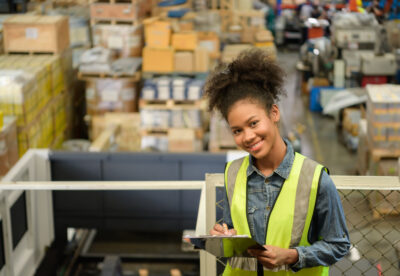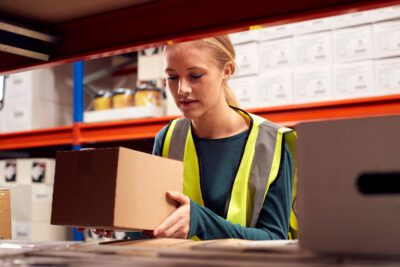Webinar Registration: The P2G Advantage
Webinar Registration: The P2G Advantage LEARN MORE
What is a Dark Store? Benefits for the Retail Industry
Mary Hart, Senior Content Marketing Manager

In 2020, retail stores had to rethink how they fulfilled increasing online orders and handled the reduction of in-store shoppers. Even as some customers headed back into stores to shop in-person, the appeal continued of quickly and easily buying items online to be picked up curbside or delivered.
When COVID started, online orders and curbside pickup or home delivery for food and other items became the norm rather than the exception. Consumers realized the ease, safety, and convenience and retailers ramped up their online order offerings. In fact, Technavio's market research report estimates the online food delivery services market will have a compound annual growth rate (CAGR) of almost 29%, with a growth of $631.84 billion from 2020-2024.
Due to the demand for online orders, smart retailers are moving to a combination of in-person retail stores and a concept known as “dark stores”. There are lots of benefits of a dark store, but let’s begin with a definition of the term “dark store,” if it’s a new one to you.
What is a Dark Store?
When you hear the term “dark store”, you might think it’s a store that has closed down as the lights have been turned off, so it has gone dark. Instead, a dark store is a retail store that exclusively focuses on online orders. These stores, which have also been referred to as “back of store” or “micro-fulfillment centers,” don’t have in-person shopping. Instead, orders are placed online, fulfilled at these dark stores, and either delivered to the customer’s home within a few hours or picked up outside the store at the customer’s scheduled time.
While dark stores can offer just delivery or just curbside pickup, the strongest stores offer both choices to give customers a choice. According to a Forrester consulting study, 35% of consumers choose shipping options like curbside pickup in order to receive their orders when they want them instead of waiting for a delivery time.
In order to offer curbside pickup and same-day delivery, dark stores are typically set up in the suburbs and outskirts of cities. They can be located in the back of a retail store, or have their own separate building or space. Often, the site of a dark store is a former retail store that the owners needed to repurpose due to a lack of in-store business and razor thin margins.
In the UK, Tesco opened its first dark store in 2009, but here in the US, retail stores have only recently started to make the move. Commercial real estate services firm JLL noted that Walmart has added automated mini warehouses, of 20,000 to 30,000 square feet, to its current stores to increase delivery and pick-up times. And they’re not alone. Research and Markets found that annual micro-fulfillment center installations will grow more than 20x by 2030, from a total of around 50 in 2020 to roughly 6,600 dark stores in 2030. Further, they noted that there will be one micro-fulfillment center for every 10th of the U.S. total 40,000 retail stores by 2030.
5 Benefits of a Dark Store
There are five top reasons why a retailer store would want to create a dark store:
- Order accuracy. The orders are placed on what is actually in the store at any given time, so the customer gets what they ordered instead of a replacement chosen by a designated shopper.
- Inventory management. The accuracy holds true for both orders and inventory, as items are scanned and inventory records updated the moment that an item is taken off the shelves for an order.
- Reduced cycle time. Customers want their orders within a day, if not within an hour in some cases. Melissa Valentine, Director of Retail Global Accounts at Locus Robotics, states that dark stores offer increased speed and efficiency, which reduces the cycle time to the customer receiving their order.
- Reduced spend on design. Dark stores don’t need to have the sleek aisles and end caps of a retail store. Instead, they can look like a warehouse, which saves the store owner money that can be spent on automation and technology.
- A combination of human and robot workers. Smart dark stores use a combination of humans and robotics with the human associates focusing on the tasks that require brain power and aren't as tough on the body.
Robotics in Dark Stores
AMRs such as those from Locus Robotics will help improve dark store and back of store operations in all areas, including each (or piece) picking; pallet transportation; case picking with pallet moving; and heavy payloads.
Valentine says, “AMRs from Locus Robotics can help profitably fulfill orders in dark stores as retail stores notoriously have razor thin margins and lose money on in-store fulfillment. With the lack of infrastructure needed, we can easily drop into a dark store and mobilize Bots around their network as Retailers keep working through their fulfillment strategy. As their strategies change, our Bots can scale up and grow with them.”
The Locus solution dramatically improves worker productivity for your dark store or brick and mortar retail store by 2x to 3x, enabling higher pick rates, lower labor costs, and faster cycle times. In addition, your warehouse associates can seamlessly alternate between picking and re-stocking/putaway, helping improve the overall efficiency of your warehouse operation and save labor costs with true task interleaving.
Ready to learn how our Locus solution can help you optimize your retail warehouse or dark store automation and improve efficiency?




